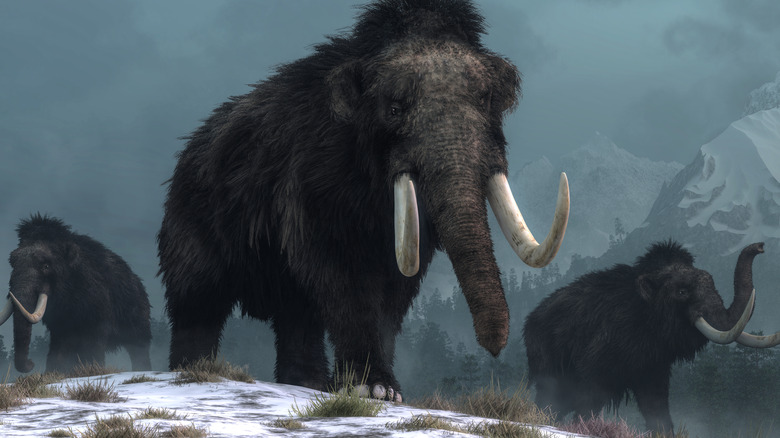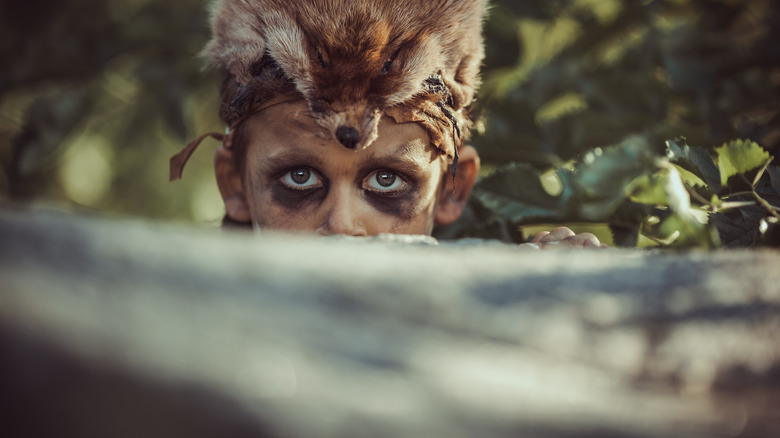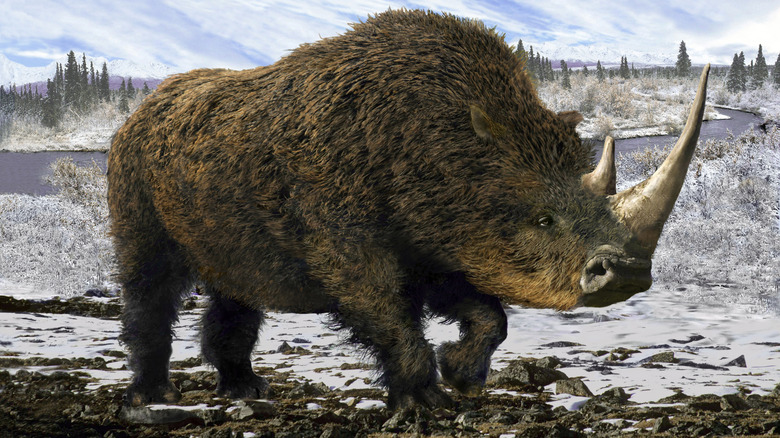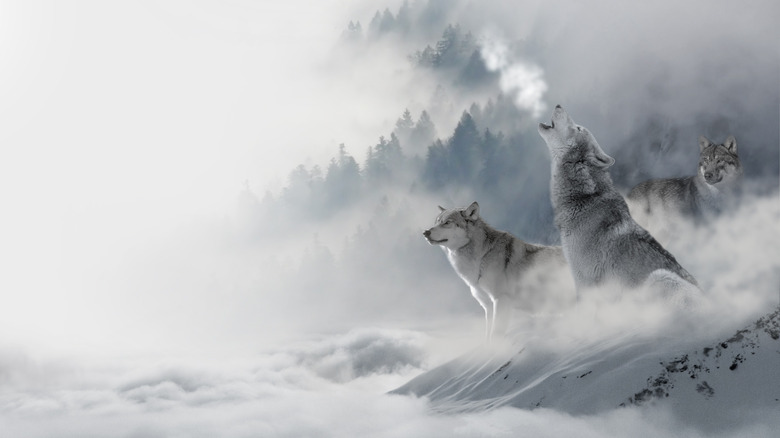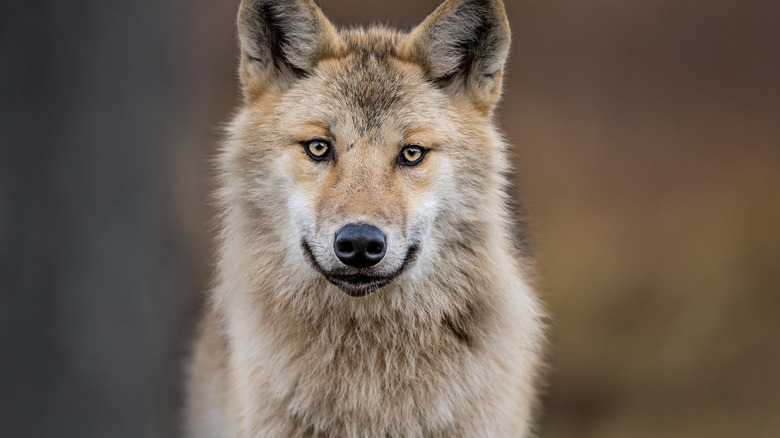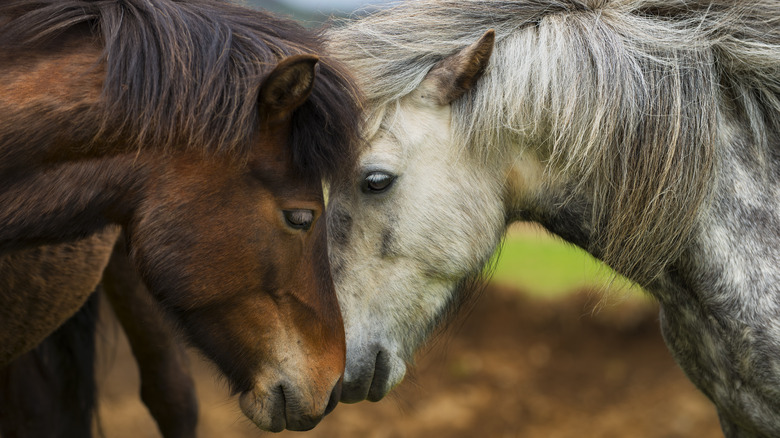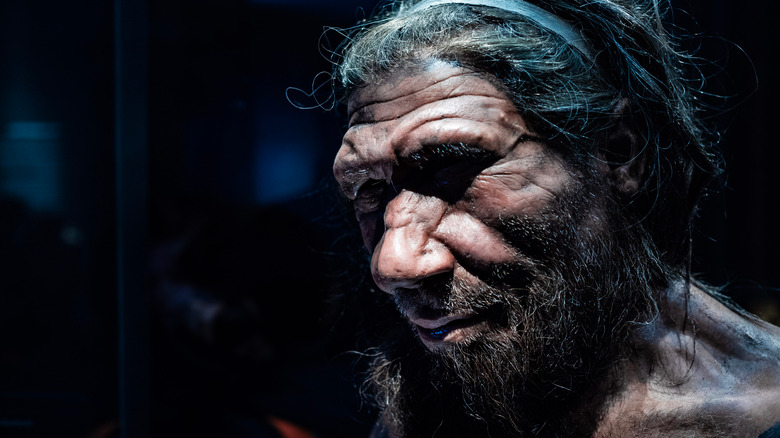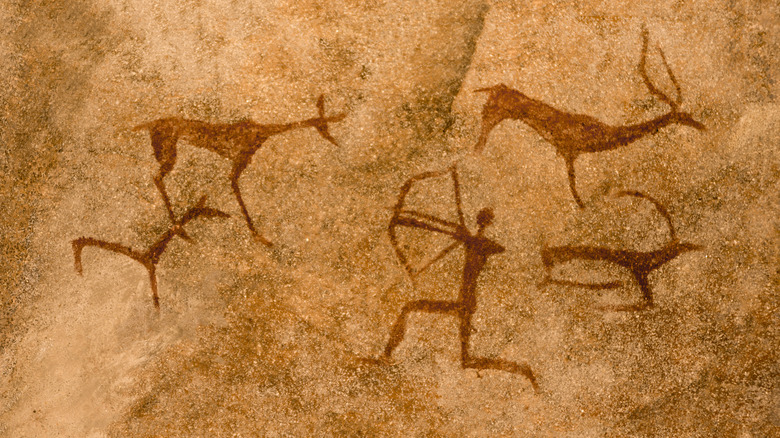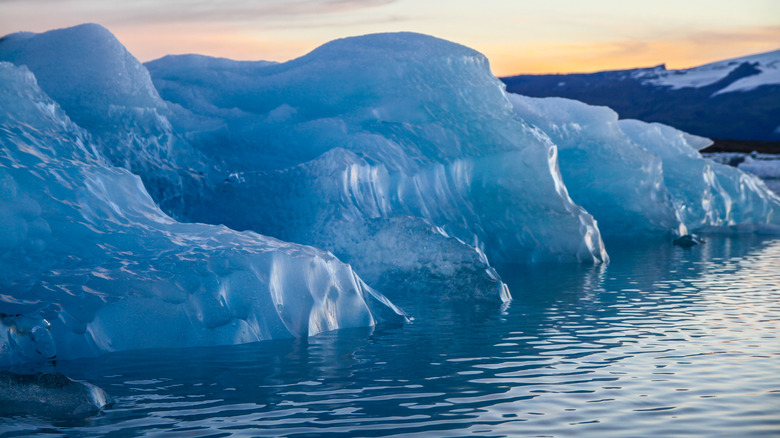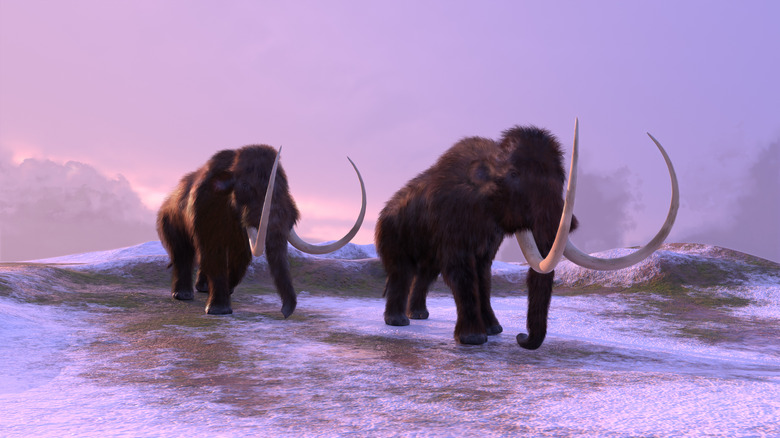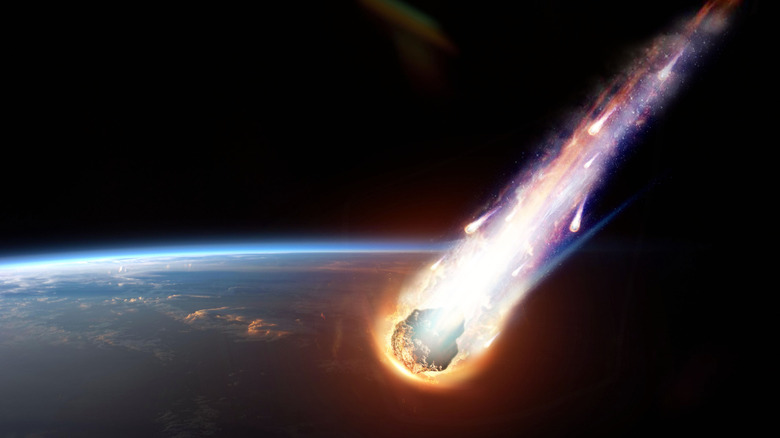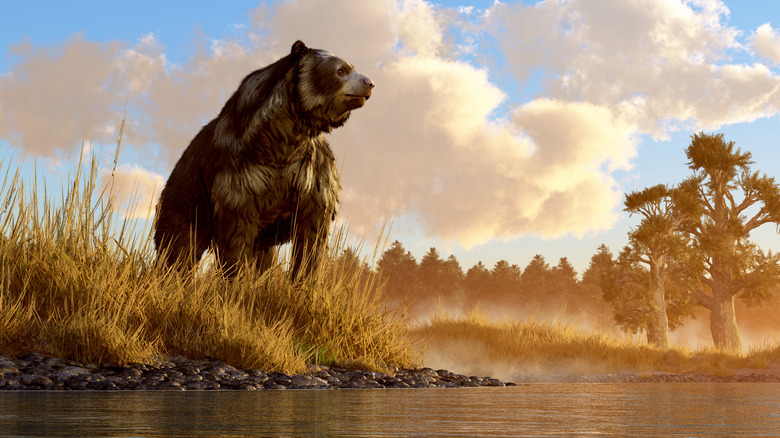What Actually Happened To The Species Of The Ice Age
In the grand scheme of things, the last ice age didn't happen that long ago. It's considered part of the Pleistocene Epoch, which started 2.6 million years ago ... give or take, says LiveScience. The last ice age reached its peak just around 20,000 years ago and when compared to the age of the planet, that's pretty much yesterday.
The Earth went through a series of sweeping changes during the last ice age, but it didn't take much: The average global temperature was only about 10 degrees cooler than it is today, according to the National Oceanic and Atmospheric Administration. It was enough to trap a larger-than-usual amount of water in the form of ice and leave the world a colder, drier place that forced the animals that roamed the planet — including man — to adapt or die.
The ice age ushered in a mass extinction event that destroyed most of the megafauna that had dominated the landscape: animals like mammoths, mastodons, ground sloths, and giant cats. When the dust settled, at least 38 groups of mammals disappeared entirely from North America. Others were vastly and forever changed, surviving by adapting to this new world. The ice changed the world forever with some species thriving and others vanishing for good.
Humans and animals gravitated toward warm spots across the globe
As the name "ice age" suggests, it was a time when much of the earth was covered in literal ice. According to the Government of Northwest Territories, not all of the planet was completely ice-covered — the habitable regions that existed are now called glacial refugia.
These spaces became an oasis for species who were looking for new places to thrive and survive as their long-time habitats grew inhospitable and finally uninhabitable. They gravitated to glacial refugia and lived alongside plant and animal species that were already well-established in these places. That is, at least for a while.
Penn State University's Beth Shapiro says that in many cases, this pushed animals into close contact with humans, who recognized them as a source of food, hides, and even weapons (via EarthSky). Discoveries of cooked bones — and bones turned into weapons — have been found, suggesting this newfound closeness led to humans having a profound impact on species across the world. Interestingly, new ice age-era refugia are still being discovered: In 2016, the University of Huddersfield released their findings (via Phys.org) pointing to a newly-discovered area on what's now the Red Sea plains, where ancient animals and humans migrated to find respite from the cold. Today, refugia remain hotspots of biological diversity.
Some animals were prepared for the ice age already
When it comes to changes the planet experienced during the last ice age, it's not all doom and gloom. In some cases, research suggests animals who had previously evolved to adapt to ice age-style conditions were able to spread throughout a newly frozen world.
Where did these animals come from? According to research done by the University of Southern California, there's evidence that animals — including varieties of horses, sheep, antelope, and badgers — evolved in the cold, snowy climate of ancient Tibet, then migrated to other areas.
Researchers determined, for example, that the remains of a 3- to 5-million-year-old fox discovered in the Himalayas is actually the ancient ancestor of today's Arctic-dwelling fox. It offers a new version of events, where previous theories suggested today's Arctic animals evolved from animals that always lived in the area.
Similar discoveries have been made about the woolly rhino, according to NPR. These massive beasts roamed across Asia and Europe around 2.5 million years ago. But when researchers found a rhino skull in Tibet, they found it pre-dated not only the European and Asian rhinos, but the ice age itself by about a million years. Adaptations that allowed these animals to live in the high, cold Tibetan mountains — like their massive size — also allowed them to spread. As the last ice age turned the world into a life-or-death struggle for many, it turned it into a winter playground for Tibet's cold-weather giants.
The largest predator to survive successfully adapted
The gray wolf is a surprisingly ancient creature. According to the Illinois State Museum, gray wolves first started to spread across North America in the mid-Pleistocene era, and — although some small populations died out — the species survived the ice age. The story of their successful adaptation is fascinating.
When researchers from Canada's Carleton University (via Science Alert) analyzed the teeth and bones of wolves who lived between 50,000 and 26,000 years ago — then compared them to modern wolves — they found, surprisingly, wolves hadn't been subjected to the same scarcities other species fell victim to during the ice ages. Wear patterns on the teeth revealed they were eating meat, not harder foods like bones, and further studies on the bones revealed they continued to hunt (instead of scavenging) by expanding their food sources — by a lot.
Early ice age wolves subsisted mainly on prehistoric horses, with supplemental meals of sheep and muskox. Later — and even today — it's moose and reindeer that make up the bulk of the gray wolf's diet, which suggested a few things to researchers. As other predators died, wolves had less and less competition for food. But they also had less food, so they adapted to hunt new prey outside of their long-time plains habitats. They ventured into forests, targeted new animals, and their resourcefulness secured them a position as one of the largest predatory mammals to survive the ice age.
Dogs survived by becoming domesticated
A world without dogs is something no one should ever have to imagine, but a world before dogs? According to research from archaeologists working with the Finnish Food Authority, the ice age — with both humans and dogs struggling to survive — likely led directly to the domestication of dogs.
Our hunter-gatherer ancestors had a problem: Not only were plants scarce, but constantly consuming lean meat from animals like deer (without supplementing with fat and carbs) can cause a condition called protein poisoning. Healthline says it causes things like low blood pressure, headaches, weakness, and — perhaps most crucially — food cravings. Ice age humans would have been craving fat, but the number of animals they'd have to kill to get life-sustaining amounts of fat would result in more lean meat than the hunters could safely consume.
All that extra meat would get tossed to the wolves, who were smart enough to recognize a good thing when they saw it and opted to follow groups of humans as they traveled. That includes following people across the then-exposed Bering Land Bridge, according to researchers from Durham University (via CNN). Humans made the trip around 15,000 years ago (thanks to low water levels), and brought their dogs with them. Today, native dogs that thrive in the Arctic can still trace their ancestors back to Siberia.
Horses had a wide variety of experiences
Millions of years ago, horses roamed across what's now the Americas, but at the end of the last ice age — about 10,000 years ago — they went completely extinct on the continent. According to PBS's Nature, not only does no one know why, but it makes no sense. Horses are adaptable, intelligent, and have powerful survival instincts. Herds also would have been able to travel great distances to find food. Still, they wouldn't return to the Americas until the 1400s, so ... what gives?
There are a few theories, with one of the major ones suggesting that a changing climate put horses in more direct competition for resources. With less food, they began to get smaller. Smaller horses couldn't travel as far, they continued to struggle, and human hunters did the rest.
So, why didn't horses go extinct entirely? Here's where things get super interesting, because a study from the Universidad Nacional Autónoma de México tried to answer that exact question, and found some fascinating things (via Cosmos). Using a combination study of geography and genetics, researchers discovered that as the ice age receded, European horses adapted to live in more heavily wooded areas — leaving the grasslands behind. Interestingly, they also changed color: While genetic analysis revealed that grassland-dwelling horses were bay or brown, those that adapted to survive the ice age evolved darker coats — likely as a way of camouflaging themselves against the darker surroundings of the forests.
All other hominins disappeared
Strangely, when it comes to humans, things get a little shaky. According to Discover, there were a whole bunch of pseudo-humans at the beginning of the ice age, including Neanderthals, the Denisovans of Asia, and the Homo floresiensis — nicknamed the Hobbits — in addition to our own Homo sapiens. By the end? Our ancestors were the only ones left standing. Just how all that went down is still hotly debated, but there are some front-running theories.
Unfortunately, not many reflect well on humans as a whole, particularly considering one of the most oft-cited is simply that H. sapiens spread throughout the territories of their close relatives, and went a'murdering as they went. But, good news! The Smithsonian's Human Origins Program paleoanthropologist Rick Potts says actual evidence of this happening is pretty non-existent. Currently, a front-running theory is that smaller populations of hominins were unable to adapt to the tens of thousands of years of cold, and met their end from a combination of starvation and freezing.
Archaeologists are a little more certain about what was going on with humans. According to History, it was during the last ice age that humans were starting to make tools, develop systems of communication, dry and preserve meat, make art, and perhaps most importantly, learn to pass along information via storytelling. The wisdom of one generation allowed for the survival of the next, and that's something relevant to 21st-century humans, too.
Human hunting hurried along some extinctions ... maybe
There are two major theories regarding what caused the bulk of the mass extinctions that came along with the ice age: climate and humans. On one hand, there are the results of studies like the 2011 one from the University of Copenhagen (via ABC Science), which determined that it was the perfect storm of increased hunting, changing habitats (and habitat loss), along with climate change that caused extinctions on a shocking scale. On the other hand, a 2014 study from Aarhus University covered in Science Daily declared it was absolutely humankind's fault and that animals probably would have struggled but survived if it wasn't for human interference. Researchers say it was a combination of killing animals directly and killing animals lower down on the food chain that destabilized the entire environment.
It's the latter theory that's supported by research projects like the 2019, multi-institution study that investigated the extinction of European cave bears, according to Phys.org. Researchers found that while cave bears had successfully thrived through prior ice ages, human hunters wiped them out in the last ice age — likely for a combination of food and to use their caves as shelter.
Nothing exists in a bubble, and University of Bath paleontology lecturer Nicholas R. Longrich says in a story from The Conversation that after the Ice Age ended the megafauna — which may or may not have been entirely our fault — humans were forced to find another way to survive. And that? Farming, agriculture, mass domestication, and civilization.
Extinction hit the oceans, too
While the planet's surface was busy freezing, what was happening to life in the oceans? It turns out it was dying.
In a 2021 study from Oregon State University, researchers think they have a pretty good idea about what was happening. In a nutshell, the heavy ice that formed on the surface kept sections of the ocean from circulating gases like oxygen, smothering what was beneath it. Climate scientist Andreas Schmittner explains, "The sea ice is effectively like a closed window for the ocean. ... [T]he sea ice acted as a barrier to keep oxygen from entering the ocean, like stale air in a room full of people."
The ice age was devastating to scores of marine life. According to the Geological Survey of Norway, oceanic life in the Arctic exists in pockets of ice-free areas called polynyas. During the ice age, though, the pockets — normally formed from winds above and warm water rising from below — largely disappeared, and with them, countless species. It's estimated that it took around 2,000 years for the oceans to recover the life lost during the ice age. According to a study from the University of Zurich (via The Maritime Executive), casualties included 9% of sharks, 35% of sea birds, and almost half of sea turtle species.
The terrible end of the woolly mammoth
Deciphering what happened to animal populations that lived thousands of years ago is obviously a bit of a challenge. Still, there's one incident that stands out from all the rest, and it's the end of the woolly mammoths.
The majority of woolly mammoths died out around 10,500 years ago — except for a single group that migrated about as far north as it's possible to go. During the ice age, they were able to walk to a landmass that rising sea levels would eventually turn into an island as the planet started to warm again, says LiveScience. And then? They would die there, after about 6,800 years of inbreeding.
In 2020, CNN reported on the release of a University at Buffalo study on the genes of the last remaining woolly mammoths. Researchers discovered some terrifying mutations that would have made the mammoths' final days chaotic, painful, and pretty heartbreaking. Among the mutations they discovered were ones that would have interfered with motor control, fertility, and cognition. Researchers add that it's likely they no longer had a sense of smell (which, they say, would have made the establishment of social ranks next to impossible). The last wooly mammoths also had genetic markers associated with diabetes and another gene seen in mice that causes a thin, satin-like, cream-colored coat — deadly for the Arctic-dwelling mammoths (via Science).
There's a theory many species died in a comet impact
So, here's a weird thing: It turns out that an 1883 writer (and congressman) named Ignatius L. Donnelly may have been onto something when he theorized that the lost continent of Atlantis was sunk during a comet strike.
Big Think reports there is something to the theory, except for the Atlantis part — although scientists are pretty sure the Younger Dryas impact happened about 13,000 years ago, not 12,000 years ago as Donnelly suggested. The general idea is that the impact caused a global winter, kicked off the ice age, sped up mass extinctions, and pushed humankind toward establishing civilizations instead of sticking with the hunter-gatherer lifestyle.
Sounds unlikely? While Forbes says a 2018 discovery of two potential impact craters in Greenland hasn't cleared anything up, there is some intriguing evidence that suggests the extraterrestrial body may have broken up in the atmosphere before throwing the world into complete chaos. In 2021, researchers from the University of Edinburgh looked at the contents of soil layers, taken from four different continents and 100 different locations. They were eerily similar, showing geochemical signals — including high levels of elements in the platinum group, a signature of a comet — that suggest something otherworldly impacted the planet all those years ago.
End-of-an-era climate change and moisture
Gone are the days of seeing megafauna like mammoths and mastodons roaming across the landscape, and that's a bummer. There's been a ton of debate about exactly what happened to cause such a massive shift in the planet's ecosystems, and according to a 2017 study in Nature and Ecology, the root culprit was something microscopic: moisture.
At the very end of the ice age — as temperatures were starting to shift and rise again — there was a catastrophic collapse in the populations of megafauna, from mammoths to the saber-toothed tiger. Researchers from the University of Adelaide analyzed samples of bones and teeth from megafauna across the globe and found that as ice, glaciers, and permafrost were starting to melt, entire biomes were changed — with particularly devastating changes to the grasslands.
While grasslands had provided for megafauna for generations, the release of this additional moisture turned them into swampy bogs. That, in turn, kick-started the fragmentation of entire populations, dividing once self-sustaining numbers into smaller, less stable, and less genetically diverse populations. It happened more in northern climates than throughout Africa, which makes sense: Africa's megafauna was less hard-hit than the giants of other lands. While not all scientists agree, says Newsweek, it's a compelling piece of research that helps to explain just why so many animals disappeared from the world forever.
